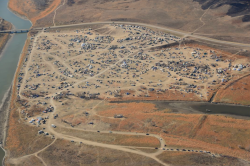News | November 19th, 2016

By C.S. Hagen
BISMARCK – North Dakota Highway Patrol Lt. Tom Iverson’s police radio crackled to life; Standing Rock activists were caravanning toward Bismarck.
Troopers patrolling alongside the convoy stayed in constant contact over the radio, watching to see if the activists split up.
“We’ve lost the front part of the convoy,” a voice on the police radio said.
A bulletproof vest and a black cudgel were stowed in the cruiser’s back seat. Iverson’s government-issued Glock handgun sat holstered at his waist. During his 13 years with the Highway Patrol, he has drawn the weapon, but has never fired his sidearm in the line of duty.
“We had all sorts of commotion yesterday,” Iverson said. In North Dakota, the No DAPL National Day of Action disrupted commerce on the BNSF railroad for more than three hours. Pro DAPL supporters lined up against anti DAPL activists at the U.S. Army Corps of Engineers center; law enforcement prepared for confrontation. Pro DAPL activists named the oil pipeline “Mary.”
“I’m always careful of the word peaceful,” Iverson said, “because a peaceful protest would require the sense of calm. There has been no calm in any of this.”
“They’re trying to slow down, it looks like they’re going down Memorial Highway, they’re eastbound,” the police radio said.
“10-4.”
“Right now the plan is to drive around a little bit, monitor things,” Iverson said. He shifted the cruiser into drive; a couple just chose Bismarck’s Capitol grounds as a good place for a domestic quarrel.
“Obviously, I am biased, but there is overwhelming support for law enforcement,” Iverson said. “That being said, you can support law enforcement and be anti pipeline. I see no problem with that, or why anyone would have a problem with that.”
One male was arrested at the scene of the domestic quarrel, and Iverson turned his attention toward more than 175 activists who were gathering at the Bank of North Dakota, and at North Dakota National Guard Fraine Barracks.
“I could care less about the pipeline,” Iverson said. He’s careful not to lump the activists together, after all, Standing Rock is a neighbor; many in Bismarck have friends and family there. After the controversy dies down, they will all need time to heal and work together again. He also understands the majority of activists at Standing Rock are peaceful, but adds there is a violent group bent on doing whatever it takes to stop the pipeline. His job is to protect everyone: the peaceful, the potentially violent, the civil disobedient, DAPL workers, the area’s citizens, and fellow officers. He prefers helping the asphalt’s stranded change flat tires to the recent front lines in Morton County.

“I truly enjoy working with people and helping people,” Iverson said. “I know that sounds cliché, but I get more of a kick out of driving up on somebody and helping them change their tires. Seeing the smile on their face that I’ve helped them out for the day. That’s something that people overlook at times: we are public servants. That being said, the laws of North Dakota were made by the people. We are charged with enforcing those laws, so it is a representation of the people as a whole.
“We don’t want to make arrests. Quite frankly, it is a pain in the butt and takes a lot of time.”
Although DAPL is nearly finished, Iverson’s instincts tell him the controversy may get worse before it gets better. There is no solid intelligence that predicts the violence will increase more than it has, “but it’s always a possibility. Personally I would say when the time gets closer to boring under the river, the final piece, it would only make sense that those who are committed to civil disobedience and violence will go to more desperate measures.
“Some will do whatever it takes.”
And the North Dakota Highway Patrol, along with other agencies involved, will do whatever they have to do in response, and for as long as it takes, he said. Departments involved are emotionally exhausted. Lines are strained. “This is very taxing on our officers, and from a budget standpoint, it’s costing taxpayers a large amount of money, but it is needed, and it is justified. But we will do whatever it takes to make sure that we are keeping up and providing adequate resources to do what the citizens of North Dakota expect us to do.
“Will it be stressful and taxing? Definitely.”
So far, Morton County Sheriff’s Department has spent more than USD 10 million taxpayer dollars since August. The state is paying for all assisting personnel, according to State Representative Mary Schneider D-N.D.
“But it’s time to figure out something else,” Schneider said. “I don’t know what that is, but the federal government should step in and find a solution to put this back together. It’s not fair to the local tribe and the local ranchers, farmers and taxpayers.”
Iverson has received many emails and telephone calls from people who feel law enforcement response has been brutal and unnecessary. Less than five emails, he said, were from North Dakota residents.
Frustrated
Today, DAPL’s drill pad, surrounded by deep ditches, a 15-foot HESCO bastion topped with razor wire, is poised like an army in ambush, less than a quarter mile from the Missouri River. Video footage from media outlet Digital Smoke Signals shows drill equipment has already arrived. Recently, U.S. Army Corps of Engineers temporarily denied Dakota Access Pipeline workers the easement needed to burrow under the Missouri River at Lake Oahe, a declaration called hypocritical by the Morton County Commission Chairman Cody Schulz.
“The scope of the federal government’s inaction is breathtaking,” Schulz said. “They have not only furthered the uncertainty of the situation and prolonged the outcome, but have at the same time refused law enforcement resources requested by the county and state to deal with a situation that is to a very large degree a federal issue. I find it more than a little hypocritical that the USACE and DOJ can stand up in a federal court and argue that all laws, regulations, rules, and policies were followed in their permitting of the project, and after a federal court agrees with them they backtrack and delay the final easement for more study.”
“We believe this is unnecessary and problematic delay that does nothing but continue to prolong the difficulty that we have as a state and as counties dealing with this great challenge,” North Dakota Governor Jack Dalrymple said. “Increases our costs and increases the risks of something happening that everybody will regret, and it is a mistake on behalf of the Corps.
“But as long as the federal government continues to allow protesters to camp on federal land near Cannonball without a permit, in other words to be there without permission, and as long as they fail to make a decision on the easement we believe this situation will continue. We have no choice…”
During a press conference, Dalrymple evaded a direct question if his office has contacted the U.S. Federal Marshal's Office for assistance, but added that under normal circumstances the task of cleaning out the camps outside of Standing Rock would be a job for the U.S. Federal Marshals to lead. He said he has asked for federal assistance, but none has been forthcoming.
Dalrymple is frustrated “on every level,” he said. “The primary level where the frustration comes is simply the inaction on the part of the government, first the U.S. Army Corps of Engineers. We have come to believe that it is not really just the Corps itself, but the Department of Interior, Department of Justice, they have co signed letters to us that this should be delayed.”
Nearly two weeks ago, Dakota Access Pipeline’s parent company, Energy Transfer Partners, said through its CEO Kelcy Warren it will begin digging under the river within 14 days.

If DAPL begins horizontal drilling, Iverson will make sure the work is shut down immediately and violators arrested, he said.
“We are not in DAPL’s corner,” Iverson said. “We absolutely would not allow something unlawful to continue. If that can provide a peace of mind to protesters out there, I am on record right now saying that will not be happening, so without the proper permits and easements, we would not allow that to happen.”
“We’ll keep an eye on them… found one of the security guys here and he’s broadcasting the message over his walkie-talkie…” the police radio interrupted. “They seem to be willing, at least open to assemble where we’re directing them to. I do see a bunch of guys with large knives on their belts, other than that just a lot of flags again.”
Despite Iverson’s instincts citing possible escalation of violence in the near future, the Cass County Sheriff’s Office began returning home on Thursday, November 17, in time for the upcoming winter storm, Cass County Sheriff’s Office Public Information Officer Kim Briggeman said. Morton County officials said Cass County Sheriff’s troopers were home on Friday, but Cass County Sheriff Paul Laney did not return telephone calls for comment.
“All these DAPL days are running together,” Briggeman said. “But there was a time of need and our agency stood up just as many agencies did in North Dakota.” Briggeman would not comment on activities in Morton County, but did say Cass County Highway Patrol troopers responded again on August 15, and the department’s sheriff, who has been serving as Morton County’s operations chief since August was expected to return before the weekend. Additional troopers responded to a “code red” call from Morton County on the No DAPL National Day of Action, Briggeman said.
On the front lines
Iverson flipped through notes taken on the No DAPL National Day of Action. License plate numbers and states were penned neatly on a legal pad. Only one vehicle was from North Dakota, the rest came from California, Utah, and elsewhere.
“It shows you the out-of-state influence that is coming into the state of North Dakota,” Iverson said. “If there was that much support from citizens of North Dakota, I think we would be seeing a lot more vehicles from North Dakota out there.”
He’s been on the front lines. Recalled the day law enforcement evacuated the northern “Treaty Camp” on lands taken over by indigenous eminent domain declarations.
“As much as I would love to be the tough guy, it’s a fearful situation,” Iverson said. “It’s a surreal moment, where we are on the front line and are face to face with people who are trying everything they can to escalate the situation, such as lighting cars on fire, throwing logs, rocks, and sticks, and feces at officers. It’s a very surreal moment and we need to keep our composure.”
North Dakota has never seen nor handled such mass violence before, he said. The DAPL controversy is a historical event, and the eyes of the world are upon the Peace Garden State. The United Nations, President Obama, and the U.S. Army Corps of Engineers have petitioned Energy Transfer Partners to voluntarily halt pipeline construction, but the company plows ahead, destroying burial grounds and sacred sites, according to a September 2016 lawsuit against the U.S. Army Corps of Engineers and filed by former Standing Rock historic preservation officer Tim Mentz Sr.
Not once have law enforcement outnumbered the activists, Iverson said. Their nametags are now hidden because officers were targeted. Some received death threats; others were followed home.
“Early when this was going on, we had numerous officers being followed home, they had death threats because they were able to follow the officers home and gather information from the officers because they knew their names. This is something that is very concerning and we have zero time for that. Our families are all involved in this.” The practice of releasing police officers’ names is known as “doxing,” and is used by groups such as Anonymous, according to the Morton County Sheriff’s Department.
Now, Iverson always doubles back at night, watching for following cars. He rarely takes the same route twice.
“Could somebody say I’m fear mongering? Maybe. But where there are active threats out there, and the fact that some have been followed home...?” Iverson stopped to answer a call on the police radio.
“It’s an intimidation factor. My family and law enforcement families should not have to deal with that.”

Although those at Oceti Sakowin say they are unarmed, Iverson said they’ve found guns and ballistic armor.
“They’ve said all along they have no weapons. I would say to the person who says that to me: ‘can you vouch for everyone out here?’ It’s a bold faced lie.”
Iverson has also investigated social media, looking for additional threats. He’s found pictures of people posing with weapons threatening to come to Cannonball to “kill a pig,” he said.
“How do we not take that seriously? That’s the other part on being on the front line, knowing there could be a lone wolf in the group that may have a weapon, such as a gun, and would want to do harm to law enforcement. There are people who would love nothing more than to kill a law enforcement officer.
“In fact, it happened on Thursday, October 27, when a lady tried to fire on law enforcement. Knowing this is out there and we’re walking into that, that’s a stressful situation to be in.”
Red Fawn Fallis, 37, was charged with attempted murder after allegedly firing three shots at law enforcement officers during the clearing of the northern Treaty Camp, according to Morton County Sheriff’s Department.
“Some would argue those are empty threats,” Iverson said. “I would argue, that those people are angry at the situation, and we all know that law enforcement has been killed, and nobody wants that happen.”
With the recent rise in fake news posted often on Facebook, Iverson said that the rumors law enforcement sent aircraft to demoralize the activists, that officers have urinated on native belongings, that the departments involved are racists, are untrue.
“I understand I may not be able to convince everyone, but nothing could be farther from the truth. We probably have law enforcement who do not agree with the pipeline, but we, as law enforcement take an oath of office, and we take that seriously.”
Has law enforcement response been perfect?
“Nobody is coming out of this smelling like roses,” Iverson said. The relationship between Highway Patrol and Standing Rock historically has been good, he said, and after this controversy passes, he hopes it will improve.
The militarization of law enforcement is partly to intimidate, in the hopes that people will back down quickly from any situation. The use of Bearcats however, is for their own safety. He recalled the night at Backwater Bridge when Molotov Cocktails were thrown at the police line. His cruiser would have taken heavy damage, and put his life in jeopardy, he said.
“Do we need to be conscious of the aggressiveness of our look? Yes. But at the same time we need to have the resources available to us to keep us safe.”
At every event, law enforcement has repeatedly petitioned the activists to disperse before resorting to less-than-lethal weapons, Iverson said. Tear gas, Tasers, pepper spray, and rubber bullets are used at an officer’s discretion for crowd dispersal, and only after all attempts have been made to clear an area.
“But we get beat up on both sides,” Iverson said. Law enforcement is a primarily a reacting force during standoffs. “We’re always behind the eight ball.” Some people have condemned law enforcement actions for not arresting sooner, he said.
Bismarck Police Chief Dan Donlin agreed. “Bismarck, Mandan, we’re not used to this. There’s the ‘arrest them all’ advice that we get, and then there’s you’re being way too oppressive and too heavy handed because these people are being prayerful and peaceful. But we also know masked in that area… is violence and potential for violence. Law enforcement is caught in the middle.”
“They want you to draw blood,” Hollywood actor Mark Ruffalo said during a Standing Rock meeting on Friday. “They want to be able to crush you with their weaponry with their tanks with their armor with their might with their force, you’ve seen it, I’ve seen it. They want you to draw first blood so they can crush you. They lose when you remain peaceful.”
Police have seen peaceful rallies and violent rallies, but most rallies contain a mix of both peaceful and violent agitators, Donlin said. He also warned those supporting police, and those who are pro DAPL, to abide by the laws.
Throughout the Peace Garden State, there is large support for law enforcement, and Iverson feels that the citizens in the area are “sick and tired of violent acts and unlawfulness.” If the activists were all white, Iverson said there would be no difference in law enforcement reaction.
“It wouldn’t be any different,” he said. “To think we would do anything to demoralize my friends, neighbors, and family, is incorrect. Law enforcement is made up of the people, from all walks of life.”
Anthony Rogers-Wright, the police and organizing director for Environmental Action, stated racism is at North Dakota’s core and the DAPL controversy combined with Trump’s recent election, is bringing the hatred “out of the woodwork.
“This is not just about an environmental issue, this at its core is racism,” Rogers-Wright said. “This pipeline was slated to go through a majority white community, they rejected it and said basically said send it to the Native American area, let that be the sacrifice.”

Local negative reaction is worsening now that native peoples are standing up for themselves, he said. Hatred has been given a license. Incidents such as the one involving a local DAPL worker who nearly ran over activists and fired a sidearm six times in the air last week, will increase. “It’s emboldening them to basically point guns at native people at native women, and yell things out of their cars.
“This is an environmental issue, but starts on a platform of racism.”
The fine line
Standing Rock and the tribe’s supporters have the Constitutional right to protest, but Iverson recommends everyone to stay at Oceti Sakowin, or the Seven Council Fires camp to make their voices heard.
To protest peacefully is legal; civil disobedience carries consequences, Iverson said.
“Once that line is crossed, you are doing more harm than good,” he said.
In August when Standing Rock Sioux Tribe Chairman Dave Archambault II pushed his way through a police crowd and when horses charged the police line, forcing retreat, and in late October when buffalo were herded towards police flanks, the protest is no longer deemed peaceful, Iverson said.
Activists argue that Archambault’s actions were heroic, that the sudden appearances of wild horses, gold eagles, and buffalos, even winter’s slow arrival, are nature’s responses to an invasion of greed. A curse lies on those who dig up sacred grounds, Mentz said during a hearing at Standing Rock, and it is a curse coming from the earth, from disturbed spirits who will rise with vengeance to drive DAPL workers mad.
Civil disobedience is typically a conscious decision made by an activist, protester, or water protector to affect change. While law enforcement arrests those who break the laws, the civil disobedient are defying what they consider laws already broken by Energy Transfer Partners.
Author and long-time environmental attorney, Robert F.Kennedy Jr., visited Standing Rock this week and condemned Energy Transfer Partners saying their actions were illegal.
“The arrogance to break the law and then the ability to get away with it,” Kennedy said to a group of people outside of Oceti Sakowin. “Not only that but when people stand up peacefully to ask the law be enforced, instead of aligning itself with the law abiding citizens of our country, the power of this state, and other states are aligning themselves with the law-breaking entity.
“I know that what they’re [Energy Transfer Partners] doing is illegal. They’re trying to build this pipeline fast, so they don’t have their day in court.” A reporter asked Kennedy what was the point of protesting any longer now that the pipeline is almost finished.
“I told the reporter if you have people robbing a bank and they came in the bank with their guns blazing, and they tied up people and they started emptying the cash register, and the police then came, do you think the police would say, ‘well, they’ve gotten this far we ought to just let them take the money.’
“What’s the difference? What they’re doing is a crime, an environmental crime, and there are real victims.”
The fast tracked pipeline is an old trick approved by the U.S. Army Corps of Engineers, a loophole in environmental assessment laws. “This company took this little loophole and tried to draw it around a 1,200-mile pipeline. It’s called segmentation, it’s an old strategy, a device of chicanery.” By segmenting the pipeline route into small sections for approvals nullifies the need for a full environmental impact assessment along the entire route. A fully assessment would certainly be denied, Kennedy said.
The pipeline will produce the same amount of carbon as 29 coal burning factories, he said.
“They use a flim-flam to break the law, and now when peaceful protesters say they want to see a cost benefit analysis, the company says no we’re not going to do that. This pipeline is not going to benefit the American people, it will benefit a few billionaires like Donald Trump, and it’s going to make them richer by impoverishing the rest.”
Another argument made by the Standing Rock Sioux Tribe is that the pipeline is on lands that belonged to them under the 1851 Treaty of Fort Laramie. Their eminent domain declaration at the northern Treaty Camp was on lands that belonged to the tribe until the U.S. Army Corps of Engineers took the land away after devastating floods incurred by the Pick-Sloan Missouri Basin Program from 1944. More than 200,000 acres of Indian land was flooded because of the project, effectively impoverishing many within Standing Rock tribe whose old homes are at the bottom of Lake Oahe, where the Dakota Access Pipeline plans to run.
Iverson understands the validity of Standing Rock’s claims to their homeland, but such issues are for the courts, not for the police, he said. Trespassing will always be trespassing, he said.
Criteria for conducting a legal protest include obtaining a legal license. If a protest becomes disorderly, marches on private property, or disrupts a city’s function, the protest then becomes unlawful. No protests on private property are legal, Iverson said, unless, of course, permission is granted by the owner.
Staying at the main camp Oceti Sakowin is not good enough for many of the activists involved with Standing Rock. Every day DAPL construction is halted is considered a victory, and every time activists are able to reach DAPL equipment, construction workers must stop, Iverson said.
“I understand that at times they are able to halt or stop construction,” Iverson said. “So in a sense, they have been successful. But, just because you believe in something so strongly, that doesn’t give you the right to engage in illegal activities. We as a society cannot accept that.
“My recommendation is to remain peaceful and prayerful and to conduct those activities within the areas they have been allowed to camp in. They’ll claim they won’t be able to have their voice heard from there, but that’s not true. There are many, many media who go down there on a daily basis.”
The Dakota Access Pipeline controversy remains in limbo; both sides say there is a front line, and both sides believe their fight is right. Activism against the pipeline will continue; law enforcement will keep making arrests. All sides involved are not willing to capitulate, even on the eve of another Dakota winter as the “black snake” slithers toward the Missouri River.

Recent Events
Thursday: An additional eight people were arrested after 130 activists marched on Bismarck’s Wells Fargo main office. Six activists made their way into the William Guy Federal Building as well, locked arms, and refused to leave, Morton County Sheriff’s Department reported.
Thursday: Activists released the name of a Bismarck police officer, according to Morton County Sheriff’s Department, and the North Dakota Legislative Management voted 10 – 3 to forego formal events, including a State of the Tribes address, due to security reasons surrounding the Dakota Access Pipeline, according to North Dakota Legislative Management.
Thursday: Internationally, on November 17, Norway’s largest bank, DNB, sold its assets in the Dakota Access Pipeline, according to Greenpeace Norway. Its decision came after the bank received 120,000 signatures urging the bank and other financial institutions to pull finances from the project.
Friday: More than 130 felony charges against activists dismissed by Morton County courts.
Friday: Morton County Sheriff’s Department condemned Oceti Sakowin, saying that activists’ attempts at winterizing break federal guidelines. “Inhabitants are fortifying their encampment by constructing temporary and permanent structures without a permit,” Morton County Sheriff Kyle Kirchmeier said. The North Dakota Department of Health activated a low power radio transmitter that operates at 1620 AM, which will be transmitting public health, safety, and other information near to Oceti Sakowin.
A total of 486 people have been arrested in connection with the DAPL controversy since early August, according to Morton County Sheriff’s Department. A total of 1,287 officers from 25 counties in North Dakota, 20 cities, and nine states, which include Indiana, Louisiana, Minnesota, Montana, Nebraska, Ohio, South Dakota, Wisconsin, and Wyoming, have assisted Morton County during the DAPL controversy, according to rom Morton County Sheriff's Department.
September 19th 2024
June 20th 2024
April 18th 2024
April 18th 2024
April 18th 2024
__293px-wide.jpg)




